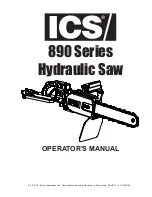
12
GB/IE
Attention:
To remove the cutting waste, first switch off the saw and
wait for the saw blade (5) to stop.
7. Secure larger workpieces against tipping after the cutting
process (for example a reel-off stand etc.).
ATTENTION:
The parallel stop must be set parallel with the saw blade (see
9.6). Check the alignment. Ensure that the parallel stop is firmly
seated at regular intervals during use and after longer periods
not in use. Tighten the screw again and adjust the parallel stop
(see 10.4.3) if necessary. Vibrations can loosen screws and
change the position of the parallel stop.
11.1.1 Cutting narrow workpieces (fig. 21)
Be sure to use a push stick (14) when making longitudinal cuts
in workpieces smaller than 120 mm in width. The push stick
(14) is included in the scope of delivery! Replace worn or dam-
aged push stick (14) immediately.
1. Adjust the parallel stop (7) according to the predefined
workpiece width (see 10.4).
2. Push the workpiece with both hands. Always use a push
stick (14) in the area of the saw blade as a pushing aid.
3. Always push the workpiece through to the end of the riving
knife (3).
m
WARNING:
With short workpieces, use the push stick (14) from the begin-
ning.
11.1.2 Cutting extremely narrow workpieces (fig. 22)
Be sure to use a wooden push block when making longitudinal
cuts in very narrow workpieces with a width of 30 mm and less.
The wooden push block is not included in the scope of delivery!
(Available from your specialist dealer) Replace the wooden
push block without delay when it becomes worn.
During sawing, workpieces can become jammed between the
parallel stop and the saw blade, caught by the saw blade and
then ejected at speed. For this reason, the lower guide surface
of the parallel stop should be favoured (see fig. 14). Shift the
stop rail if required (see 10.4.2).
1. Adjust the parallel stop according to the cutting width of
the workpiece.
2. Use the wooden push block to press the workpiece against
the stop rail and use the push stick (14) to push the work-
piece through to the end of the riving knife.
Never use the wooden push block to press the workpiece
against the saw blade (5). There is a risk of jamming or kick-
back.
11.1.3 Performing angled cuts (fig. 23)
Angled cuts are always made using the parallel stop (7). The
parallel stop (7) must always be fitted to the right of the saw
blade. Otherwise, workpieces can become jammed between
the parallel stop and the saw blade during sawing and ejected
at speed.
1. Set the saw blade (5) to the desired angle (see 10.3).
2. Adjust the parallel stop (7) according to the workpiece
height and the desired width (see 10.4).
3. Make the cut according to the workpiece width (see 11.1).
11.2 Performing longitudinal cuts (fig. 24)
1. Slide the transverse stop (2) into the groove (40) of the saw
table and set it to the required angle (see 10.5).
2. Use the stop rail (17)
3. Firmly press the workpiece against the transverse stop (2).
4. Switch the saw on.
5. To make the cut, slide the transverse stop (2) and the work-
piece in the direction of the saw blade (5).
m
WARNING:
Always firmly hold the guided work-
piece firmly, never the workpiece that has been cut off.
6. Push the transverse stop (2) until the workpiece has
reached the end of the riving knife (3).
7. Switch the saw off again.
8. Do not remove the cutting waste until the saw blade has
returned to its resting position.
11.3 Cutting chipboard
The saw blade (5) must not be set higher than 5 mm above the
thickness of the workpiece (see also 10.2). This prevents the
cutting edges from breaking when cutting chipboards.
12. Transport (fig. 25, 26)
• Always switch off the electrical tool before transport and dis-
connect it from the power supply.
• Lower the saw blade (5) as far as possible.
• Wind up the mains cable (41).
• Place the parallel stop (7) in the holder (46) provided.
• Carry the power tool with both hands by the fixed saw table
(1). Never use the table width extension to carry the power
tool.
• Protect the electrical tool from impacts, shocks and severe
vibrations, e.g. during vehicular transport.
• Secure the power tool against toppling and slipping.
• Never use protective devices for handling or transport.
13. Maintenance
m
WARNING:
Pull out the mains plug before carrying out any adjustments,
maintenance or repair work!
13.1 General maintenance tasks
• Keep protective devices, air vents, extraction openings and
the motor housing as free of dust and dirt as possible. Re-
move shavings and dust with a vacuum cleaner and a brush.
In addition, blow it out with low-pressure compressed air.
• We recommend that you clean the device directly after every
use.
• Clean the device at regular intervals using a damp cloth and
a little soft soap. Do not use aggressive cleaning agents or
solvents; they could attack the plastic parts of the device.
Make sure that no water can penetrate the device interior.
• Oil the rotating parts once monthly to extend the life of the
tool. Do not oil the motor.
13.2 Carbon brushes
• If excessive sparks are generated, have an electrician check
the carbon brushes. Attention! The carbon brushes must only
be replaced by an electrician.
















































